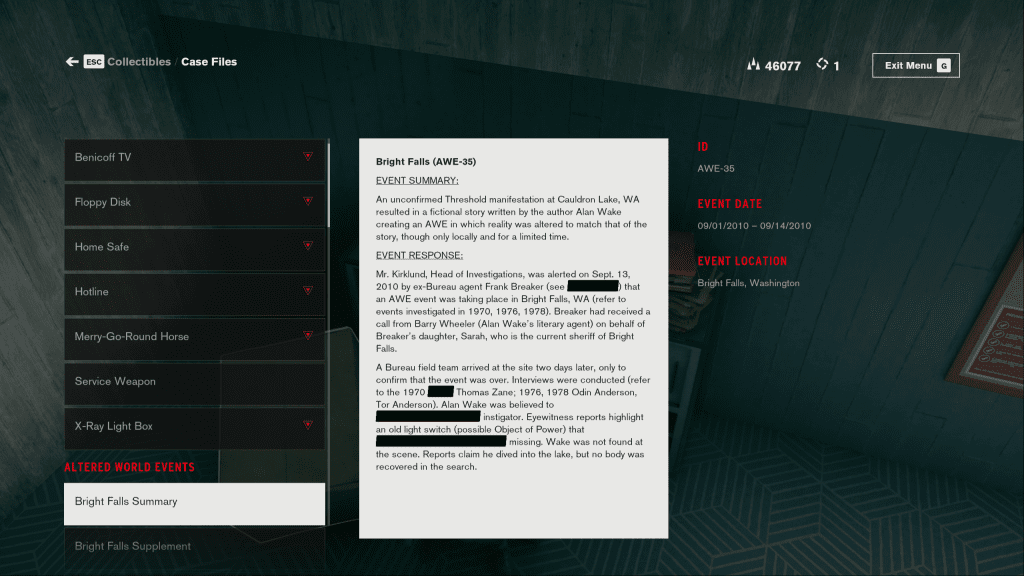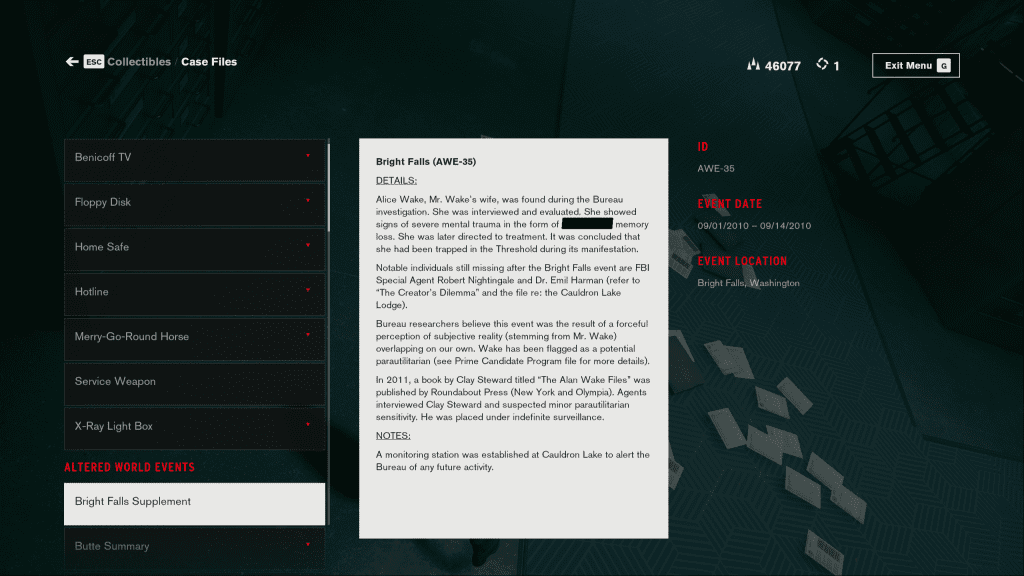WARNING: MAJOR SPOILERS AHEAD for Remedy Entertainment’s new game Control. Please do not read this article if you haven’t completed the main story, or aren’t willing to have one of the game’s major twists revealed.

“It’s not a lake, it’s an ocean.”
Fans of Remedy Entertainment’s enigmatic mix of supernatural mystery, world-class combat and encounter design, and innovative storytelling devices may find that these words, spoken by the eponymous main character of Alan Wake, in the final moments of that game’s shocking cliffhanger ending, suddenly have a new meaning. The world of each of Remedy’s games, be it 2016’s Quantum Break, the legendary Max Payne franchise, Alan Wake, or their new instant classic supernatural thrill-ride Control, are not lakes. They are oceans, connected together in some strange way, the answers obscured, buried away in their dark, aquatic depths.

One of the most brilliant revelations in Control (which we gave our first ever perfect score in my review) comes toward the end of the game, when main character Jesse Faden suddenly begins discovering documents related to Alan Wake. At first, the references seem subtle: a Bureau proposal refers to the fictional TV program Night Springs, often found playing on television screens in Alan Wake.
But as the game ramps up the intensity and moves towards its thrilling conclusion, references to Alan Wake start increasing. It soon becomes obvious that the universe of Control and Alan Wake are one and the same. It’s clear that Control isn’t just referencing Alan Wake by way of Easter eggs, but providing answers, and perhaps even functioning as a sequel in a limited way.
But before delving into the nature of that relationship, it’s worth addressing some of the other connections between Remedy games and Control. None of these links are as clear or consistent as the one between Control and Alan Wake, and feel a bit more like Easter eggs.

In Quantum Break, a chalkboard in Riverport University contains a series of frantic scribblings related to Alan Wake. Some of these seem to lack any real significance. But in the bottom left, the letters AWE are underlines in two phrases. The first says “Alan Wake Experience” and the phrase below says “Altered World Events.”

Altered World Events, or AWEs, are the central plot device in Control. These events cause elements of the paranormal world to spill into the natural world, like the discovery of The Oldest House, the Slide Projector incident in Jesse’s home town Ordinary, and indeed, the appearance of the Dark Presence in Alan Wake. This leads to the inevitable question: does Quantum Break also take place in this universe? Graffiti with the letters “AWE” are found scrawled on some walls in the game. The events of the time break and stutter phenomena seem consistent with the incident at Riverport University being an example of an AWE. Could the time machine built by Jack Joyce’s brother William be an Object of Power?

When Jesse finally reaches her hiss-infected brother Dylan in the later chapters of Control, he reveals a series of strange dreams to her, in some of the game’s most chilling story sequences. In one, Dylan describes being “in a dark place, and there was a dark man there.” This man, who Dylan refers to as Mr. Door, says there are many worlds that exist side by side. In one world, Dylan describes a writer who creates a story about a cop. In another world, he says, the cop is real.
This seems like a reference to Max Payne’s protagonist, a disillusioned ex-cop, suggesting that the world of Max Payne exists as a parallel dimension to Alan Wake and Control. But what about the writer? Is that referring to our world? To Sam Lake, creator of Max Payne and the rest of Remedy’s post-Payne output? Or is it another reference to Alan Wake, whose main character writes a crime novel paralleling the story of Max Payne?

The depth of the connection between Alan Wake and Control is remarkably wide-ranging by the end of the game’s main story path. When Jesse reaches the Prime Candidate Program, we discover that the events in Bright Falls at Cauldron Lake are an AWE the Bureau investigated. The document describes an ex-Bureau agent tipped off by Barry, Alan’s agent. Does that mean Barry already aware of the paranatural world before the events of Alan Wake?
By the time the Bureau reached Bright Falls, the incident was over. The document dated from 2010 refers to interviews the Bureau conducted, but strangely reference case files from the 1970s: an interview with Thomas Zane, the writer whose voice guides Alan, and Odin and Tor Anderson, a reference to the in-universe band Old Gods of Asgard, alter-egos for real life Remedy mainstays Poets of the Fall.

A file hidden away by the twisted corridor in the Prime Candidate Program tells us more about what happened after the events of Alan Wake. Alan’s wife Alice was found, shell-shocked and traumatized but alive, during the Bureau’s investigation, confirming that Alice managed to escape the Dark Presence. FBI agent Nightingale, on the other hand, is missing. The document suggests that the cause of the events in Alan Wake sprung from Wake’s nature as a “potential parautilitarian,” causing the fictional events of Wake’s stories to spill into the real world. The author of a book chronicling the Wake story, Clay Steward, is said to have “suspected mild parautilitarian sensitivity.”

In one of Control’s more disturbing documents, a page said to have been discovered in the Oceanview Motel and Casino contains words clearly written by Wake. He says that he has been trapped with the Dark Presence for ten years, trying to write his escape, but only sinking deeper. In a scratched out portion, it’s said the words “Falls,” “haunting,” “Wake,” “light switch,” and “ocean” were found, confirming the document’s connection to Wake.
It’s a terrifying thought: Wake has spent the last ten years trapped by the Dark Presence, desperately trying to write his way out, to manifest his words, but only finding the distance between fiction and reality vanishing even more. Like Agent Cooper trapped inside the Black Lodge at the end of the Twin Peaks’s original broadcast run, it’s a sad, terrifying place to leave one of Remedy’s most beloved characters.

Control has a smattering of other Remedy references, including a document in the Dead Letters section of the Bureau talking about a vision of a “small, empty town” with a “Lake at its center” (note the capitalization of Lake. We see you, Sam!) where “shadows of people moved around,” which sounds an awful lot like Bright Falls.
And, remarkably, a piece of viral marketing for Alan Wake called This House of Dreams even referenced Jesse’s home town of Ordinary, suggesting Lake had the idea for the Ordinary AWE all the way back in 2011. A song from Alan Wake’s American Nightmare in 2012 contains this hidden message when played backwards: “It will happen again, in another town. A town called Ordinary.“
There are perhaps even more references waiting to be discovered by intrepid Astralnauts willing to dive even further into Control’s many hidden areas. But even with these documents and sequences alone, it’s clear that Remedy have finally sown together the threads linking their games, moments and references that in the past could be dismissed as Easter eggs.

But not anymore: Control makes the nature of this shared universe crystal clear. The subtext has become text, and the Easter eggs cracked and whipped into omelettes. Control feels like the culmination of everything Sam Lake and his creative team at Remedy have been working towards for years. The Federal Bureau of Control, The Oldest House, and the Altered World Event phenomena are the key that unlocks the remarkably strange and beautiful world Sam Lake has created. And I can’t wait to discover the next chapter.
Editor’s Note: thanks to Mark Delaney and this piece over at TrueAchievements. While I had the idea for this article before reading that piece, finding his article helped me flesh out some of the details of Quantum Break’s Alan Wake/Control references.